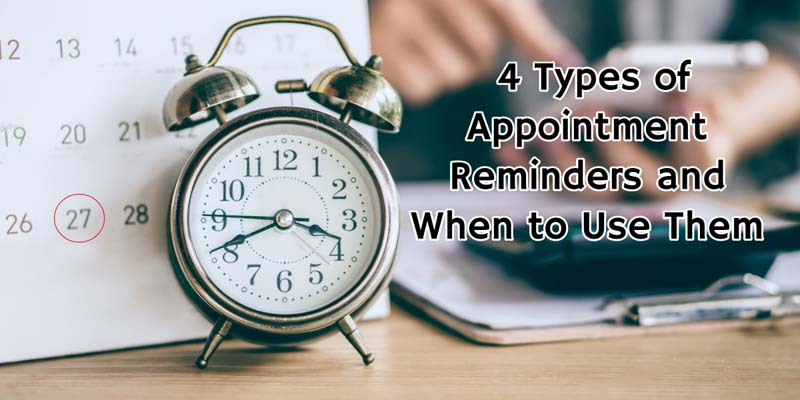
Phone calls, emails, text messages, direct mail: as a service provider, you have a variety of options when it comes to reaching out to your clients and reminding them about upcoming appointments. Your goal, always, is to maintain positive contact with your patients and clients and to reduce costly no-shows.
You do not want to annoy your clients or turn them off to your business or your services by overwhelming them or interrupting their day with too many messages from your office. Your goal should be to find just the right balance in your usage of appointment reminder emails, appointment reminder messages and appointment reminder texts.
So how can you find that balance? Read on for tips to help you think through how to best maximize your appointment reminder services, help your clients, and reduce your no-shows.
Types of Appointment Reminders- And Why You Should Have Options
Most businesses are realizing that it’s not enough to have one stream of client communication. It’s important to be communicating with your clients through the right channels at the right time, and even to be offering options to them about their preferences on how they’d like to be contacted.
When clients first sign up with you for a service, we recommend that you offer them at least two options for how they would like to receive their appointment reminders. Research shows that when clients tell you how they would like to be reminded, no-show rates drop dramatically.
There are four different main types of appointment reminders and reminder systems that you can use. The best choice for you and your business will depend entirely on the type of business that you are running, the needs and tasks of your staff and the needs and preferences of your clients:
Phone calls, either done by live people, or as automated calls run through a system, are one of the oldest and most traditional forms of appointment reminders. These reminders can be time consuming if you do them with live staff members.
However, if you have front desk staff who spend a great deal of time idle, it can be a good way to use their time efficiently while providing a personalized touch for clients who prefer phone calls.
Another option is to use a service that automates your phone call reminders and uses a computerized or recorded voice to call your clients and give them a reminder.
No matter which type of appointment reminder phone message you are using, the recommended timing for a phone call is one day prior to the appointment.
Some clients or patients will prefer to receive an appointment confirmation email instead of a phone call (or in addition to an appointment reminder phone message). Many people find written communication less intrusive than a phone call, and many of us use email regularly enough (perhaps even all through the day).
One advantage to using email for appointment reminders is that it is easy to use a service to automate the sending of appointment confirmation emails, reducing the amount of time that employees and staff need to use in sending the messages.
There is, however, always the danger that appointment confirmation emails will end up in the spam folders of your client, or will be overlooked in the large amount of email that many people receive in their inbox in a daily basis.
If you are going to use appointment confirmation emails, experts recommend you send them three days prior to the appointment.
One increasingly popular way to reach clients and patients with appointment reminders is through SMS text messaging. Most people, including your clients, carry their cell phones with them at all times, virtually guaranteeing that a reminder text message will reach them when you send it.
Text messages, when set up through a service, are also very easy to automate, using little staff time and are an efficient way to send the short reminder to your patients or clients about their upcoming appointment. When asked about their preferences for appointment reminder messaging, many clients pick text messaging.
It is important to remember that text message appointment reminders should not be your only option, as text messaging for lower income or older clients can be difficult. It is best to keep some traditional offerings (such as phone calls) available.
When you set up a system to send appointment confirmation text messages, it is recommended that you do so to send the text two days prior to the appointment.
One of the newest pieces of technology that has arrived is the appointment reminder app. Some businesses and offices are asking patients and clients to download appointment apps that make it easier to schedule appointments, and then automatically generates reminders for the client.
The pros of this approach are that the apps on the market seem to work really well for those who use them. They are multi-functional and work seamlessly between client and provider.
The cons, as you might imagine, have to do with cost and client resistance to downloading something new onto their phone. Not every new client is going to be willing to download a new app just to be able to stay in touch with your business. Especially with new customers, this is asking a level of commitment that they may not be willing to give.
Given that there is more than one app available right now, it is possible that clients could be asked by different businesses to download different applications, leaving their phones cluttered with multiple apps for the different services they receive.
We encourage you to look into the different types of appointment reminder messages that you can send to your clients to reduce no-shows and maximize your time and efficiency. Offer choices to your clients and see how your billable time will increase!